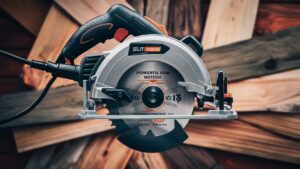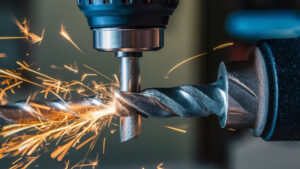Orbital sanders are ideal for larger surfaces and provide a smooth finish, while palm sanders excel in tight spaces and detail work. Choosing between them depends on your specific project needs.
Sanding tools come in various types, each suited for different tasks. The orbital sander uses a circular sanding pad that moves in a random orbit, making it excellent for flat surfaces like tables and floors. It achieves a finer finish and reduces swirl marks.
On the other hand, the palm sander features a smaller, square pad that’s easier to maneuver in corners and edges. This makes it perfect for detailed work, such as sanding furniture or trim. Understanding the strengths of each tool helps you select the right one for your woodworking projects, ensuring optimal results every time.
Introduction To Sanding Tools
Sanding tools are essential in woodworking. They help create smooth surfaces. Choosing the right sander can impact your project. Two popular options are the orbital sander and the palm sander. Each has unique features and uses.
The Role Of Sanders In Woodworking
Sanders play a critical role in woodworking. They prepare surfaces for finishing. A smooth surface enhances the final appearance. Proper sanding can also increase durability.
- Removes imperfections
- Prepares wood for staining
- Enhances paint adhesion
Using the right sander saves time and effort. It improves the quality of your work.
Primary Types Of Sanders
| Sander Type | Best For | Key Features |
|---|---|---|
| Orbital Sander | Large flat surfaces | Random orbit motion, dust collection |
| Palm Sander | Small, detailed areas | Compact size, easy to control |
Each sander type has its advantages. Choose based on your project needs.

Orbital Sanders Unveiled
Orbital sanders are essential tools for various sanding tasks. They provide a smooth finish on wood, metal, and plastic surfaces. Understanding their functions and uses helps you choose the right tool for your project.
How Orbital Sanders Work
Orbital sanders operate using a circular sanding disc. This disc moves in small orbits, creating a unique sanding pattern. The movement prevents swirl marks, offering a smooth finish.
Key components of an orbital sander include:
- Sanding pad: Holds the sandpaper in place.
- Motor: Powers the sanding disc.
- Dust collection: Helps keep the workspace clean.
To use an orbital sander:
- Choose the right sandpaper grit.
- Attach the sandpaper to the sanding pad.
- Turn on the sander and gently move it across the surface.
Common Uses For Orbital Sanders
Orbital sanders are versatile tools. Here are some common uses:
- Wood finishing: Smooth out rough surfaces on furniture.
- Paint removal: Strip old paint from wood surfaces.
- Surface preparation: Get surfaces ready for painting or staining.
- Metal sanding: Polish metal surfaces to a shine.
Consider using an orbital sander for:
| Task | Recommended Grit |
|---|---|
| Initial sanding | 60-80 grit |
| Finishing touches | 220 grit or higher |
These tools are great for both DIY enthusiasts and professionals. They save time and effort while delivering high-quality results.
Palm Sanders Explained
Palm sanders are compact power tools. They are designed for light to medium sanding tasks. These tools fit comfortably in your hand. Their size makes them easy to control. Palm sanders are perfect for detailed work.
The Mechanics Of Palm Sanders
Palm sanders operate using a simple mechanism. They use a rectangular sanding pad attached to a motor. Here’s how they work:
- The motor spins the sanding pad.
- Sandpaper is attached to the pad with Velcro or clips.
- Friction generates heat, smoothing the surface.
The motor speed is adjustable. This feature helps control the sanding intensity. Palm sanders are lightweight, making them easy to maneuver. They work best on flat surfaces.
Ideal Projects For Palm Sanders
Palm sanders shine in various projects. They are perfect for:
- Furniture Refinishing: Smooth surfaces on wooden furniture.
- Cabinet Restoration: Remove old paint or varnish.
- DIY Crafts: Sand small wood pieces for crafts.
- Touch-Ups: Perfect for quick touch-ups on surfaces.
Use palm sanders for delicate work. They are ideal for corners and edges. Their design allows for precision and control.
| Project Type | Benefit of Palm Sanders |
|---|---|
| Furniture Refinishing | Achieve a smooth, professional finish. |
| Cabinet Restoration | Easy to remove old paint without damage. |
| DIY Crafts | Perfect for precise sanding on small pieces. |
| Touch-Ups | Quickly fix scratches and imperfections. |
Palm sanders are versatile tools. They are essential for any DIY enthusiast.
Key Differences Between Orbital And Palm Sanders
Understanding the key differences between orbital sanders and palm sanders can help you choose the right tool for your project. Each type has unique features that cater to specific tasks. Let’s explore these differences in detail.
Motion And Finish
Orbital sanders and palm sanders differ significantly in their motion and the finish they provide.
| Feature | Orbital Sander | Palm Sander |
|---|---|---|
| Motion Type | Random orbital motion | Linear motion |
| Finish Quality | Smoother finish | Good for flat surfaces |
| Best For | Curved surfaces and large areas | Small projects and tight spaces |
Orbital sanders create a smoother finish due to their random motion. They are perfect for larger surfaces and curves. Palm sanders excel at flat surfaces. They provide a decent finish but may not match the orbital sander’s smoothness.
Design And Ergonomics
The design and ergonomics of these sanders also vary.
- Orbital Sanders:
- Larger and heavier.
- May cause fatigue during prolonged use.
- Handles often have rubber grips for comfort.
- Palm Sanders:
- Compact and lightweight.
- Easy to control with one hand.
- Ideal for extended use without fatigue.
Orbital sanders are bulkier. They can lead to fatigue if used for long periods. Palm sanders are lighter and easier to control. They are perfect for detailed work and longer tasks.
Comparing Sandpaper Compatibility
Choosing the right sandpaper is crucial for effective sanding. Different sanders require specific sandpaper types. Understanding these differences helps achieve better results.
Sandpaper Varieties For Orbital Sanders
Orbital sanders use various sandpaper types. They often have a hook-and-loop backing for easy changes. Common varieties include:
- Aluminum Oxide: Durable and versatile.
- Silicon Carbide: Ideal for wet sanding.
- Garnet: Provides a smooth finish.
Orbital sanders often use round sandpaper discs. Sizes usually range from 5 to 6 inches. Here’s a table of popular sandpaper sizes:
| Disc Size | Common Grits |
|---|---|
| 5 inches | 60, 80, 120, 220 |
| 6 inches | 80, 120, 150, 240 |
Choosing Sandpaper For Palm Sanders
Palm sanders require specific sandpaper types too. They commonly use rectangular sheets or pads. Here are some key sandpaper options:
- Aluminum Oxide: Great for general use.
- Garnet: Best for finishing touches.
- Silicon Carbide: Suitable for smooth surfaces.
Sandpaper for palm sanders often comes in sheets. Standard sizes are 1/4 sheet or 1/3 sheet. This ensures compatibility with most palm sanders.
The Impact On Surface Finish
Choosing the right sander affects your project’s surface finish. An orbital sander and a palm sander each offer unique results. Understanding their differences helps in achieving the desired outcome.
Quality Of Finish With An Orbital Sander
An orbital sander is perfect for achieving a smooth and even surface. It uses a circular motion that minimizes swirl marks. Here are some key benefits:
- Versatile for various materials like wood and metal.
- Excellent for finishing projects with a polished look.
- Works well on large areas, making it time-efficient.
Results can vary based on the grit of the sandpaper used. Here’s a quick guide:
| Grit Size | Result |
|---|---|
| Coarse (40-60) | Rapid material removal |
| Medium (80-120) | Good for smoothing surfaces |
| Fine (150-220) | Perfect for final finish |
Results Achieved With A Palm Sander
A palm sander offers a different approach to surface finishing. It is compact and easy to handle. Here are its main advantages:
- Ideal for smaller projects and tight spaces.
- Great for detailed work and edges.
- Lightweight and easy to maneuver.
Quality of finish with a palm sander depends on technique. Following these steps can help:
- Use the right sandpaper grit for the task.
- Apply even pressure while sanding.
- Keep the sander moving to avoid gouging the surface.
Both sanders have their place in woodworking. Your choice should reflect your project needs.
User Experience And Ease Of Use
The choice between an orbital sander and a palm sander often depends on user experience. Both tools offer unique features that influence ease of use. Understanding handling, maneuverability, vibration, and noise levels can help you choose the right tool.
Handling And Maneuverability
Handling and maneuverability play vital roles in user experience.
- Orbital Sander: Larger and heavier. It may feel less agile.
- Palm Sander: Compact and lightweight. Easy to control.
For detailed handling comparison, see the table below:
| Feature | Orbital Sander | Palm Sander |
|---|---|---|
| Size | Medium to Large | Small |
| Weight | Heavier | Lighter |
| Control | Less precise | Very precise |
Vibration And Noise Levels
Vibration and noise impact comfort during use.
- Orbital Sander: Generates more vibration and noise.
- Palm Sander: Quieter and smoother operation.
Here’s a quick comparison:
| Aspect | Orbital Sander | Palm Sander |
|---|---|---|
| Vibration | High | Low |
| Noise Level | Louder | Quieter |
Choose a tool that fits your comfort level. A palm sander offers ease for extended use. An orbital sander suits larger projects but may cause fatigue.
Pros And Cons: A Summary
Choosing between an orbital sander and a palm sander requires understanding their strengths and weaknesses. Each tool serves different purposes. Knowing their pros and cons helps in making the right choice.
Advantages Of Orbital Sanders
- Versatile: Works on various surfaces, including wood and metal.
- Efficient: Sands quickly and evenly, reducing time spent on projects.
- Fine Finish: Produces a smooth surface, ideal for final touches.
- Dust Collection: Often includes a dust bag, keeping the workspace cleaner.
- Powerful: Handles tough jobs with ease, ideal for larger projects.
Downsides Of Palm Sanders
- Limited Power: Not suitable for heavy-duty tasks.
- Less Versatile: Primarily designed for smaller, flat surfaces.
- Slower Sanding: Takes longer to achieve a smooth finish compared to orbital sanders.
- Higher Vibration: Can cause fatigue during extended use.
- Dust Management: Often lacks effective dust collection features.
Making The Right Choice For Your Project
Choosing between an orbital sander and a palm sander can be tricky. Each tool serves a specific purpose and has its own benefits. Understanding your project needs helps make this choice easier.
Factors To Consider
Several factors influence the choice of sander. Consider the following:
- Project Type: What will you be sanding? Wood? Metal?
- Surface Area: Is it a large surface or smaller areas?
- Detail Work: Do you need precision sanding?
- Sandpaper Grit: Different tasks require different grit levels.
- Power Source: Are you using corded or cordless options?
Recommendations For Different Woodworking Tasks
| Task | Recommended Sander | Reason |
|---|---|---|
| Removing Paint | Orbital Sander | More aggressive and efficient. |
| Smoothing Edges | Palm Sander | Better for detail and control. |
| Finishing Touches | Palm Sander | Great for a smooth finish. |
| Large Surfaces | Orbital Sander | Covers more area quickly. |
| Curved Surfaces | Palm Sander | Fits into tight spaces. |
Understanding these factors helps you choose wisely. Select the right tool to achieve the best results.
Maintenance And Care For Longevity
Proper maintenance ensures your sanders last longer. Regular care keeps them working efficiently. Understanding how to maintain both orbital and palm sanders is essential. Follow these tips to enjoy your tools for years.
Keeping Your Orbital Sander In Top Shape
To maintain your orbital sander, follow these steps:
- Clean the Dust Collection System: Empty the dust bag often.
- Inspect Sanding Pads: Replace worn pads to avoid damage.
- Check for Loose Screws: Tighten screws regularly.
- Store Properly: Keep in a dry place away from moisture.
Regular checks help identify issues early. Clean the sander after each use. This prevents dust buildup, ensuring smooth operation.
Palm Sander Maintenance Tips
Maintain your palm sander with these simple tips:
- Change Sandpaper Regularly: Dull sandpaper makes work harder.
- Keep Air Vents Clear: Remove debris to prevent overheating.
- Lubricate Moving Parts: Use light oil for smooth operation.
- Wipe Down After Use: Clean the exterior to avoid grime.
Proper maintenance extends the life of your palm sander. Store it in a protective case to avoid damage. Keep it dry and away from extreme temperatures.
Final Thoughts On The Smooth Finish Showdown
The battle between the orbital sander and palm sander is intense. Both tools deliver unique advantages. Choosing the right one depends on your project needs. Let’s summarize their strengths and see what future innovations await.
Summarizing The Duel
| Feature | Orbital Sander | Palm Sander |
|---|---|---|
| Best for | Large surfaces | Small areas |
| Weight | Heavier | Lighter |
| Finish Quality | Smooth and even | Good for detail work |
| Ease of Use | Requires some skill | Beginner-friendly |
| Cost | Higher | Lower |
Both sanders have their merits. For large projects, the orbital sander excels. It covers more area quickly. The palm sander shines in tight spots. It is lightweight and easy to handle.
Future Innovations In Sanding Technology
- Smart Sensors: New models may feature sensors that adjust speed.
- Dust Collection: Improved systems will reduce mess.
- Ergonomic Designs: More comfortable grips will enhance usability.
- Battery Technology: Longer-lasting batteries will boost portability.
- Eco-Friendly Materials: Sustainable options will appeal to many users.
Innovations will shape the future of sanding tools. Expect more efficiency and convenience. The evolution of these tools will benefit all DIY enthusiasts.
Frequently Asked Questions
What Is The Difference Between Orbital And Palm Sanders?
Orbital sanders have a round sanding pad that moves in a circular motion. They are ideal for larger surfaces and smoother finishes. Palm sanders, on the other hand, have a rectangular pad and are better for tight spaces. Each tool serves different purposes based on the sanding project.
Which Sander Is Better For Beginners?
For beginners, a palm sander is often more user-friendly. Its lightweight design and easy handling make it accessible for new users. Orbital sanders may require more technique to operate effectively. Starting with a palm sander allows for a smoother learning curve in woodworking projects.
Can I Use A Palm Sander For Large Projects?
While you can use a palm sander for large projects, it may not be efficient. Palm sanders excel in detail work or smaller areas. For larger surfaces, an orbital sander is more suitable. It covers more area quickly, saving you time and effort during your project.
Are Orbital Sanders More Powerful Than Palm Sanders?
Yes, orbital sanders are generally more powerful. They can handle tougher materials and larger areas effectively. Their design allows for deeper sanding, making them ideal for heavy-duty tasks. Palm sanders, while effective for detail work, lack the same power and versatility for larger jobs.
Conclusion
Choosing between an orbital sander and a palm sander depends on your specific needs. Orbital sanders excel in larger projects, while palm sanders are perfect for tight spaces. Understanding their unique features can enhance your woodworking experience. Make an informed decision to achieve the best results in your sanding tasks.








